Cynthia Bourgeault
True seekers are already in broader union, and hence beyond form and separation

Picture: Cynthia Bourgeault
Cynthia Bourgeault, the modern-day mystic, Episcopal priest, writer, and internationally known retreat leader, has just made it onto the prestigious Watkins List [/], honoring the hundred most spiritually influential people of 2021. This recognition comes partly on the strength of her acclaimed new book Eye of the Heart: A Spiritual Journey into the Imaginal Realm [/], the German edition [/] of which was published by Chalice Verlag last month. Despite her packed schedule, she kindly granted us the following interview

Picture: Chalice Publishing
Chalice Magazine: Cynthia, on May 31, friends and students of Reshad Feild around the world will commemorate his passing in 2016. You once mentioned your “heart connection in common” and wrote,
Reshad and I have been crossing paths for forty years now, just missing in human time, but still dancing in the Imaginal. Some of his students in both New Mexico and Vancouver have been my most powerful connecting rods, meters and colleagues on this journey. And his book [The Last Barrier], of course, set the bird in my heart free from its cage.
If you picture to yourself meeting him for an afternoon, apart from a jolly dance, what could you imagine talking to him about?
Cynthia Bourgeault: First and foremost about the “second” or “inner” (or kesdjan) body, which is a different and subtler vehicle for our aliveness and in the Christian inner tradition is often referred to as “the wedding garment”. And also about the higher realms, and about what cosmic service in the Conscious Circle of Humanity actually looks like when viewed from the other side. Second, about the nature of this planetary threshold / crisis humanity seems to be perched on just now, and what is really needed to bring help.

Picture: Chalice Publishing
A sturdy bandwidth of protection, blessing, and guidance around our fragile planet
Chalice Magazine: About this Conscious Circle of Humanity you write in your most recent book, Eye of the Heart,
There’s an old piece of Hasidic folklore that claims that our world at any point in time is held in its planetary orbit by thirty-six conscious human beings. They don’t know each other, and they don’t even know if they’re among the thirty-six. But the quality of their work, rising like incense into the earth’s atmosphere, creates around our fragile planet a sturdy bandwidth of protection, blessing, and guidance [page 139].
Later in the book you state,
Within my own immediate Christian lineage it seems that there has been a marked and accelerating exodus of spiritual masters to the other side. Joining Rafe [Brother Raphael Robin], who departed in 1995, are now Raimon Panikkar [/] (2010), Murat Yagan [/] (2013), Beatrice Bruteau [/] (2014), Bruno Barnhart [/] (2015), Bernadette Roberts [/] (2017), and, in October 2018, Thomas Keating [/] and Joseph Boyle [/] [page 170].
Reshad, whom we would count among this Conscious Circle, said, “The end of a cycle is not the end of possibility, it is only the beginning.” What kind of a beginning, then, could this exodus mean at this time in history?
There’s an old piece of Hasidic folklore that claims that our world at any point in time is held in its planetary orbit by thirty-six conscious human beings.
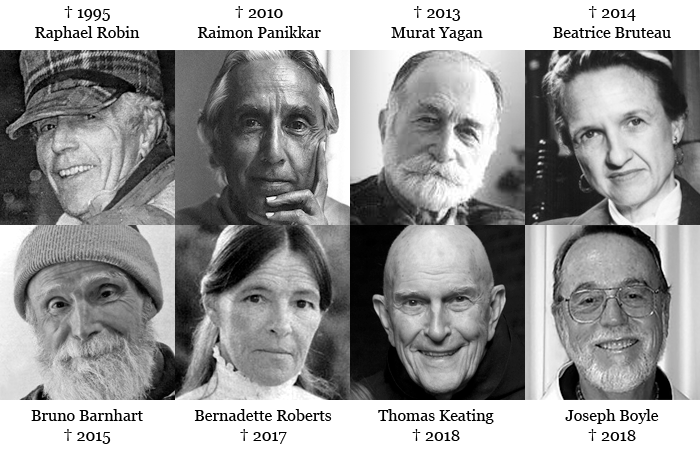
Cynthia Bourgeault: To me, it signifies first and foremost that we are going to need help and wisdom from the other side, force and clarity far beyond our own human making. In other words, it’s a BIG crisis, or a major threshold, requiring a far higher input of what Jacob Boehme [/] called “mobility and majesty”, the spiritual agency proper to worlds higher than our own. Hopefully, this might mean turning the corner into some new threshold of consciousness (the long-awaited integral emergence?), but I am reluctant to go there. My own worry is more along the lines of an Atlantis-style perturbation catalyzed by human-driven climate destabilization.
Attention is really the power to attend.
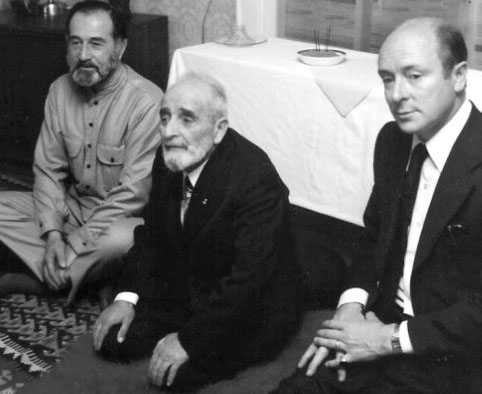
Murat Yagan, Sheikh Suleyman Dede and Reshad Feild in the early 1970s. Picture: Private archives of Reshad Feild
Chalice Magazine: In Eye of the Heart you write that
Wisdom schools tend to come above ground either on the cusps of great forward leaps in consciousness or in times of planetary destabilization, and we have seen how our own era qualifies on both counts. […] There do seem to be some features of the moment we now find ourselves in that invite us to pay attention in a special way [page 170].
Can you say a bit more about this special attention that is needed now?
Cynthia Bourgeault: Attention is really the power to attend. It is not the same as a wary, mental hypervigilance or an egoically identified “hovering”. It is a clear, objective, fully embodied capacity to illuminate a situation simply through infusing it with a kind of hypervitalization and connectivity that emerges in the simple act of attending.
Chalice Magazine: In your book The Heart of Centering Prayer [/] you quote your teacher Thomas Keating’s dictum that this practice “is done not with attention but with intention.” And “contemplation”, you mentioned in a talk at the Festival of Faith in 2019, “is knowledge impregnated by love.” How can Centering Prayer then bring us to so impregnate, illuminate or infuse our world and to so attend our day-to-day life?
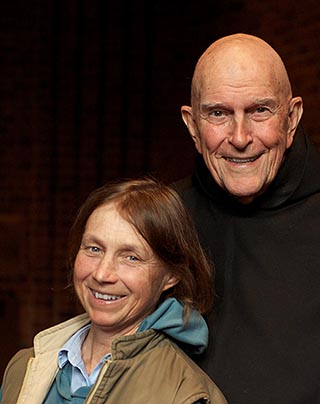
Cynthia Bourgeault with Father Thomas Keating at the Trappist Saint Benedict’s Monastery, Snowmass, Colorado, 2012. Picture: Cynthia Bourgeault
Cynthia Bourgeault: It’s important to recognize from the start that “love” does not mean the emotion of love. It’s something deeper and of an entirely different nature from emotion. Thomas tried to explain that it was closer to will – but again, this does not mean willpower. It is our small-self appropriations of these great spiritual terms that introduce so much confusion and disharmony into the mix.
My own suspicion is that “love” is the Western mystical tradition’s closest approximation of “knowledge physically grounded in the operating system of perception whose physiological nexus is in the heart.” This permits an entirely different way of perceiving and attending – without emotional turmoil, without negativity, without dualism.
When we learn to attend in this way, we do indeed “illuminate and infuse” our world with a different kind of energy. To the extent that Centering Prayer helps us to do this, by quieting our over-reliance on thinking and emoting, it is laying the foundation for this new kind of attending.
In a culture now fixated upon “identity politics” and “telling my story” the chances for broader union are not great
Chalice Magazine: Reshad’s own teacher, Bulent Rauf [/] (1911–1987) wrote to him in his final letter,
To know oneself is surely to know Him, in Whose Image one is. For the Image and the subject of that Image to unite is fulfilment; and complete fulfilment is only possible in love. Tell them that if they come to you with reservations, with prejudices, with self-centred and self-protective pettiness and bigotry, it is better for them not to come to you but to find a suitable confined form or dogma which will placate their self-righteousness. Because our way is just the opposite to this. We give up the self we have nurtured for a universal truth which is the matrix of our true self.
While religion and formalized spiritual traditions always tend to foster, to a certain degree, a self-nurturing assertion of ‘being special’, we do find in all of these traditions people who look for union rather than separation. Those who have stepped beyond form and separation, Bulent would call “People of the Way”. What do you think the odds are for a broader union among true seekers around the world?
Cynthia Bourgeault: True seekers are already in broader union; this does not need to be brought into being. In stepping beyond the need for a “self” story, and hence beyond form and separation, you are already manifesting that union, for union is what remains when the artificial boundaries have been removed. But the chances of this happening in any meaningful way in a culture now fixated upon “identity politics” and “telling my story” is not great. Fortunately, the old Hasidic story reminds us, it’s a matter of quality not quantity. Even if only a few step beyond, they carry a force which moves the whole thing ahead.
Chalice Magazine: In your book Love Is Stronger than Death (the German translation of which we are plannig to publish latest in 2022) you quote your teacher Rafe saying, “last year’s words belong to last year’s language, and next year’s words await another voice.” Maybe Bulent Rauf had something similar in mind when he used to urge his pupil Reshad, “You must invent a new language!” Talking of “true seekers”, what are their qualities? What are their characteristics? And what new language must they speak?
Cynthia Bourgeault: We do not “invent” this language; we download it directly from the imaginal by our attuned obedience. Inventing smacks of mental cleverness; obedience is literally “listening from (or to) the depths.” With this kind of listening we speak a more universally understandable language. Sometimes it is in the form of poetry, music and art, sometimes in the silence itself. What is remarkable is its universal transparency to those whose hearts are open.
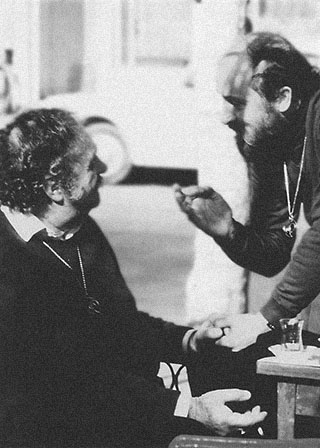
Bulent Rauf and Reshad Feild in Turkey in the early 1970s. Picture: Chalice Publishing
Chalice Magazine: In The Last Barrier, Reshad quotes Bulent saying,
We are not involved with religion or with form. We are involved with the inner meaning, the inner stream of truth that underlies all religion. Our way is not a way for those who cannot go beyond form. It is for those who wish to go straight to essence.
When seekers decide to ‘leave’ a tradition or a teaching or a group because they feel that form has crusted over its essence, because it is separating themselves from the bigger picture, or because it contradicts their longing for union, they can find themselves on difficult and lonely territory. How can they manage not to get lost? How can we come to terms with the sometimes choking necessity for form?
Cynthia Bourgeault: Meister Eckhart [/] once said, “No being without a mode of being.” I think this is true. Without form, there is no mode of articulation… So, of course it’s difficult and lonely. The trick is to cherish particularity (form) as the necessary syntax of self-communication without getting lost in it. And if one is truly beyond form, then the story of loneliness loses its hold as well. One just lives.
Chalice Magazine: Would you say our loneliness is akin to the one which God feels and wants to overcome, as He states in the famous hadith qudsi, “I was a hidden treasure and I loved to be known, so I created the world that I might be known”? Or even that our suffering is akin to the suffering of God when He has to melt form, as you said in an interview with Renate McNay [/], “like the sun yearning to hold a snowflake, He can’t do it without melting it”?
Cynthia Bourgeault: Yes, this is the right ballpark if we can hold it lightly. It is not the emotion of loneliness, the emotion of surrender – more like the “gesture” of loneliness, the “signature” of suffering. These deep, feelingful qualities are in fact vessels of universal intelligibility, sacred pathways of connectivity and compassion that flow out from the ever-hidden divine source as a fountainhead of manifestation and joy – “hiding out in endless creativity,” as Thomas Keating so delightfully puts it.
Mesoteric wisdom lineages can create beautiful bridges for seekers
Chalice Magazine: Today, more and more people are disappointed or even disgusted by organized religion and the established churches, while others (mis)use them as a kind of stronghold for their political views and to uphold their social and cultural identities. Especially people thirsting for real spiritual meaning are often frustrated and leave to go searching in other directions. Is this trend something that bothers you, or do you rather see it as an inevitable historic development or even as an opportunity? What is the point of such organizations if they fail to provide the necessary “food” for the spiritual hungry?
I have seen all too often in the New Age “spiritual but not religious” sector children who have learned to walk without first crawling.
Cynthia Bourgeault: Most authentic Wisdom teachers I know would say that every religion has a formal, rigid, and often hypocritical outer form, but that the exoteric track is absolutely foundational to going deeper. I tend to agree, having seen all too often in the New Age “spiritual but not religious” sector children who have learned to walk without first crawling. Something is lost, which must then later be broken down and refashioned, most often in the areas of humility and obedience.
Rewriting the books on one’s own – even out of desperation, in the quest for integrity – will always increase personal egoism and autonomy issues, and these must then be rectified – if they can before a student becomes unteachable. That is the petard on which we are all currently hoisted!!! Damned if you do and damned if you don’t.
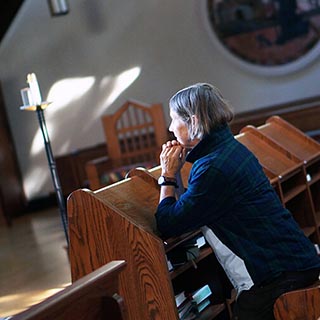
Cynthia praying at Glastonbury Abbey in Hingham near Boston. Picture: Shambhala Publications
At any rate, my own preference is to continue to try to stay in dialogue with the exoteric structures, reforming them where possible, purging them of their most blatant dysfunctions, while encouraging the authentic exoteric pastors (those with love and nurturance in their hearts) to step forward. Meanwhile, mesoteric wisdom lineages (as in some sectors of Buddhism, Sufism, and Christian Benedictine monasticism) can create beautiful bridges for seekers, offering a more authentically spiritual and mystical milieu while yet holding the line on traditional habits of respect and humility that are essential parts of the traditional adab.[1]
Chalice Magazine: In a recent interview you gave for the Website Buddha at the Gaspump [/] you said,
A spiritual seeker that doesn’t dare to screw up is going to be far more a problem to God than one who screws up and returns for forgiveness and doesn’t despair, because then you’re still teachable. But the lack of risk-taking amongst those who like to call themselves “spiritual”, because they’re protecting their image, is I think a serious drain on the energy of integrity and vitality in the transformed being.
Do you think it would help us accept risk if we were to understand, as John G. Bennett [/] suggested, that even God Himself is ‘subject’ to risk or hazard?
Cynthia Bourgeault: Yes, definitely. But few have the courage or clarity to say this. Jacob Boehme had this courage.

Jacob Boehme: posthumous portrait by Christoph Gottlob Glymann from the first half of the 18th century. Picture: Wikimedia Commons
Chalice Magazine: And you, in turn, had the courage and took the risk to embrace Jacob Boehme, whom you call “one of the underground geniuses of the Christian mystical path”, in your teaching and introduce his rather challenging thinking to a modern readership. We, for instance, are very grateful to having been directed to his writings through your books (especially The Holy Trinity and the Law of Three [/]) and were surprised to find that many of his ideas, like Meister Eckhart’s, are in close unison to the Sufi lore. Do you think he has the potential to be one of those bridges for seekers from various traditional backgrounds?
Cynthia Bourgeault: Indeed. He is one of the finest of the bridges – in fact, a main artery of the Western mystical tradition, bringing life-giving blood and oxygen to Christianity, Judaism, and Islam through their respective mystical expressions. How lovely to be able to read him easily in German! He is even more clear and eloquent in his native tongue.
In the Gurdjieff Work there is a considerable amount of reconfiguration and new life going on right now
Chalice Magazine: In your teaching you open many doors also to the Work of G.I. Gurdjieff [/], in which you participated for some ten years yourself. Some people involved in the Gurdjieff Work, on the other hand, still tend toward a certain secrecy and exclusiveness, maybe even toward the above-mentioned lack of risk-taking, when it comes to opening up and contributing their insights for the good of a greater union among the various spiritual traditions. Would you agree that this is a pity if not a wastage of a great body of knowledge?
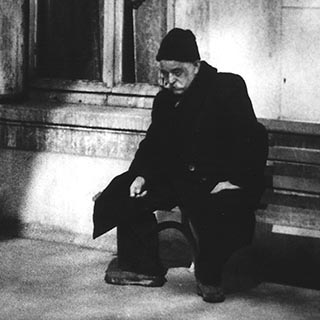
George Ivanovich Gurdjieff around 1947. Picture: The Collection of Gert-Jan Blom
Cynthia Bourgeault: There are many lines of transmission within the Gurdjieff Work, and while some lines indeed tend to rigidity and a zealous curatorship of the treasure entrusted to them, others (including the Bennett line) have been far more experimental and open to new input. And there is a considerable amount of reconfiguration and new life going on in the Work right now, occasioned by an increasing public and scholarly recognition of this tradition, passing the baton into a much more “populist” Work than I think has ever been seen before on the planet. I frankly am convinced that Gurdjieff has a direct hand in this, and that in this new configuration the “denying” (second) force carried by the conservatism of the most prominent Gurdjieff lineages will prove to wield important staying power. The game ain’t over yet.
Chalice Magazine: An important source of your own inspiration and teaching are the biblical apocrypha, such as the Gospel of Mary Magdalene, on whom you wrote a widely acclaimed book [/] (which we will also soon publish in German), and especially the Gospel of Thomas, on which you offer two wonderful online courses [/]. In what way have these scriptures changed your own understanding of Jesus, and what role can they play for today’s Christianity?
Cynthia Bourgeault: They tend to reinforce what the heart has known all along anyway about the nature of Jesus’s transmission and the arena in which it operates. They wrest it away from the control of an essentially male, priestly, “in group,” to a true Wisdom transmission governed not by form but by essence.
Inclusion is the purest essence of love
Chalice Magazine: In the practice of Centering Prayer, as taught by your teacher Thomas Keating and yourself, the gentle releasing of thoughts is known as “consenting to the presence and action of God”. According to the Sufi understanding of the meaning of Mary’s ‘immaculate’ conception, as taught by Muhyiddin Ibn Arabi [/] in The Wisdom of the Prophets [/], she exercised releasing by
taking refuge in God against him [i.e. Gabriel’s shape of a harmonious man] with all her being, and consequently she was overwhelmed with a perfect state of the Divine Presence, a state which was identical with the Intellectual Spirit (ar-ruh al ma’nawi). If Gabriel had blown his breath into her at the time that she was in this state, Jesus would have been born such that nobody could tolerate him because of his uncompromising nature, conforming to the state of his mother at the time of his conception. But as soon as Gabriel [spoke] to Mary […], she relaxed from her state […] and then Gabriel blew into her [the spirit of] Jesus.
Would you say that Ibn Arabi describes here the same releasing that should be practiced in Centering Prayer?
Cynthia Bourgeault: Offhand I would say that there is a hell of a lot of speculative theory here, both about Mary’s state and about Jesus’s, and it would not be respectful for me to comment on here without more intensive study of Ibn Arabi’s specific teaching here and the mystical context in which it is encased.
But I would say that whenever release is from an attitude – or state – of rigidity into one of gentleness, hospitality, and non-identification (even if less spiritually “perfected”), the meaning of Thomas Keating’s teaching on release is being exemplified. “Though his state was that of God, yet he did not deem equality with God something he should cling to,” Saint Paul writes of Jesus in his classic teaching in Philippians 2.6–11, “rather, he emptied himself, and assuming the state of a slave, he was born in human likeness.” I think you could make the case that in the Christian take on things, love is more pure than purity, even if (or particularly if), it must take into itself baser elements… Because inclusion is the purest essence of love.
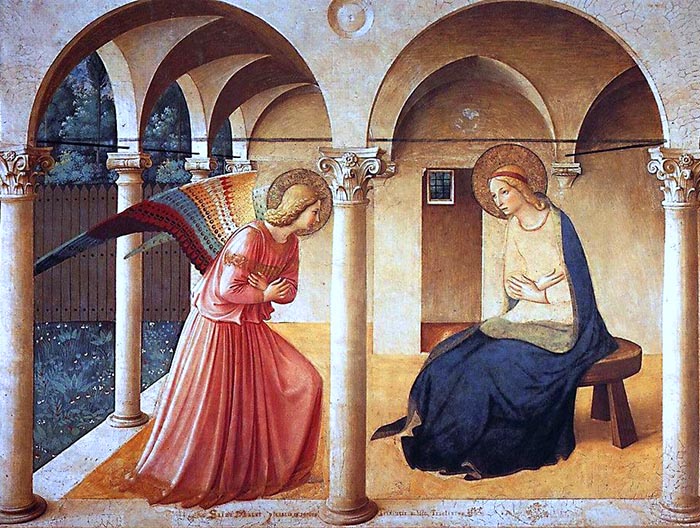
Annunciation: fresco by Fra Angelico. Picture: Wikimedia Commons
Chalice Magazine: What you say about inclusion and love is most beautiful. Isn’t inclusion, or an unreserved consent, a common characteristic of both Jesus and Mary? What would you make of the possibility, though, to understand the above quoted (Sufi) account of the conception to be what Gurdjieff would call a legominism, a vehicle to transmit knowledge over generations, (in this case: the Sufis ‘borrowing’ the famous Christian story in order to transport an important teaching of their own tradition) with Mary representing “the womb of the moment” and Jesus representing that which can be “born out of the moment”, according to the interpretation that,
“your body is the Virgin Mary. The Spirit is Christ, the Word that was conveyed through Gabriel, the eternal messenger. The breath is the breath of the Mercy of God, and it is that breath that quickens the soul” (Bulent Rauf quoted in The Last Barrier).
Is this something you can relate to according to your own understanding and teaching?

Bismillah ar-Rahman ar-Rahim (“In the name of God, the Most Compasionate, the Most Merciful”); calligraphic rendition of the first line of the Quran. Source: Wikimedia Commons
Cynhthia Bourgeault: I think this is a beautiful way of envisioning this teaching, although I would like to hear you say more about your understanding of the difference between Spirit and breath, since linguistically they are the same. For me, the Virgin Mary comes closer to rahim, the womb, or the living vessel of the Mercy of God (Rahim, “Mercy”, also means “womb” in the Semitic languages, so it is difficult to separate this function from Mary).
The engendering Spirit borne through Gabriel is what inseminates the “second birth” – or the transformation which will make manifest the essential Self (or true soul of a person), and Christ, the Word made flesh, is precisely that essential Self. I read this more as a legominism of our own second birth – our own spiritual regeneration, as it were.
But it is true that the consent, the YES to spirit, is an active and essential part of that regeneration. It is what we contribute, the “genetic material” from our own human side, which allows this second birth to be fertile and life-engendering, filled with our own transformed essence.
A true teacher is a finger pointing to the moon
Chalice Magazine: In your book The Heart of Centering Prayer you refer to the Cloud of Unknowing [/] to claim the elasticity of time, and you come to the conclusion that it essentially vanishes when we are engaged in contemplation. Ibn Arabi said much the same when he wrote, “The moment lengthens and shortens in accordance with the presence of the one who partakes in it” (in Journey to the Lord of Power [/]). “Real contemplation”, you go on to say, “is essentially an ‘out of time’ experience. Time is swallowed up not by death but by the complete reunion of wills” (page 200). What would you make then, in the light of this understanding, of that other famous Sufi saying that “time is the eternal attribute of God”?
Cynthia Bourgeault: Opinions vary on this point, but my own take is that linear time (the time we most typically experience here in our earth plane and habitually call “time”) is a function of this plane of existence only. In the next (the imaginal) realm time becomes a volume not a duration. And as one draws nearer and nearer to the primordial point of manifestingness deep within the heart of God, time becomes increasingly indistinguishable from primordial purposiveness or will. If this is what the Sufi maxim means, I would concur.
Chalice Magazine: The relationship between pupil and teacher has been a topic of discussion among spiritually-minded people from time immemorial. “When the pupil is ready, the teacher will come”, the old saying goes. But it is obvious, as Reshad pointed out, that the teacher needs the pupil just as much. Looking at your own teacher Thomas Keating and at your own pupils, what would you say is the relevance of such a relationship today? And what does “loyalty” mean (and what does it not mean) to you in this context?

Reshad Feild at Dartington Hall, Devon, 2004. Picture: Chalice Publishing
Cynthia Bourgeault: I think the teacher-student relationship is archetypal, sacred, ever-relevant, dynamic – and, as you say, mutual. Any teacher demanding personal loyalty (i.e. to himself or herself, as an individual person or a symbol of the tradition), I would run away from as fast as possible.
A true teacher is a finger pointing to the moon – through the purity of that pointing, the student is able to see the moon, and by the light of that moon, the student sees the beauty and purity of the teacher. Thus, loyalty is never demanded, but only patience to trust the process and trust the teacher until the eye of the needle has been navigated. And even here, the student’s personal integrity is never violated, even for the most sincere of reasons. Reciprocity grows out of mutual respect, humility, and trust, as binding on the teacher as on the student.
Chalice Magazine: We thank you very much, dear Cynthia, for this interview.
© Cynthia Bourgeault / Chalice Publishing 2021
For more information about Cynthia Bourgeault, please visit her website www.cynthiabourgeault.org
Notes
[1] Etiquette of courtesy. “Adab is a code of behavior that is central to Sufism, a way to walk the Sufi path with the correct attitude and true courtesy. On the deepest level, adab is the attitude of the soul before God, the way the soul bows down before its Lord with utmost respect, and then lives that respect in the outer and inner worlds” (quoted from The Golden Sufi Centre [/]).


